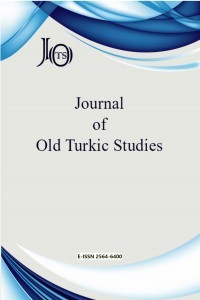Dīvānu Lugāti’t-Türk’teki Savaş Terimlerine İlişkin Bir Tasnif Denemesi
Dīwān Lughāt al-Turk is one of the most significant and ancient dictionaries in the history of the Turkish language. Composed during the Karakhanid Turkish period, this work has been extensively studied in the field of Turkology, thanks to its extensive vocabulary. In the context of this article, Dīwān Lughāt al-Turk was chosen as a primary source of data, and a fresh attempt at classification was undertaken by categorizing the war-related terms within the text under various thematic headings. Within this classification, the war-related terms in Dīwān Lughāt al-Turk were scrutinized through seven primary categories. The analysis revealed that the category of ‘Tools and Equipment’, as well as ‘Horses and Gifts’, stood out as the most frequently employed topics, constituting 48% of the usage. This was followed by categories such as ‘Words Relating to Individuals’ and ‘Expressions Used in Various War Situations’, making up 18% and 15% respectively. This article aims to introduce a novel classification endeavor on this subject, drawing from existing research on war terminology within Dīwān Lughāt al-Turk, and aims to serve as a foundational resource for future studies in this area.
Anahtar Kelimeler:
Dīwān Lughāt al-Turk, war terms, classification
A Classification Essay on War Terms in Dīvānu Lugāti’t-Türk
Dīwān Lughāt al-Turk is one of the most significant and ancient dictionaries in the history of the Turkish language. Composed during the Karakhanid Turkish period, this work has been extensively studied in the field of Turkology, thanks to its extensive vocabulary. In the context of this article, Dīwān Lughāt al-Turk was chosen as a primary source of data, and a fresh attempt at classification was undertaken by categorizing the war-related terms within the text under various thematic headings. Within this classification, the war-related terms in Dīwān Lughāt al-Turk were scrutinized through seven primary categories. The analysis revealed that the category of ‘Tools and Equipment’, as well as ‘Horses and Gifts’, stood out as the most frequently employed topics, constituting 48% of the usage. This was followed by categories such as ‘Words Relating to Individuals’ and ‘Expressions Used in Various War Situations’, making up 18% and 15% respectively. This article aims to introduce a novel classification endeavor on this subject, drawing from existing research on war terminology within Dīwān Lughāt al-Turk, and aims to serve as a foundational resource for future studies in this area.
Keywords:
Dīwān Lughāt al-Turk, war terms, classification,
___
- Akar, A. (2005). Türk Dili Tarihi. İstanbul: Ötüken Neşriyat.
- Alan, S. (2020). Dīvānu Lugāti’t-Türk’te yer alan kumaş terimleri ve kelime kökenleri üzerine bir değerlendirme. RumeliDE Dil ve Edebiyat Araştırmaları Dergisi, (20), 23-42.
- Atalay, B. (1986). Divanü Lûgat-it-Türk Dizini “Endeks”. Ankara: Türk Tarih Kurumu Basımevi.
- Çakmak, C. (2015). Dîvânu Lugâti’t Türk’te Araç Gereçlere Ait Söz Varlığı. Turkish Studies, 10(16), 427-460.
- Yayın Aralığı: Yılda 2 Sayı
- Başlangıç: 2017
- Yayıncı: Erdem UÇAR
Sayıdaki Diğer Makaleler
Kısasü’l-Enbiyā’da Oğuz Diyalekti Unsurları Üzerine
Zum Vergleich der alttürkischen und „germanischen“ Schrift und Kultur
Eski Anadolu Türkçesine Ait Bir Hikâye: Ayniddîn’in Dâsitân-ı Hatun Mesnevisi [06 Mil Yz A 3881/6]
Budist Uygur Metinlerinde Dinî Bir Terim Olarak ünüş = Skr. niḥsaraṇa İfadesi
Einige Beobachtungen zur Übersetzungstechnik der altuigurischen Maitrisimit
